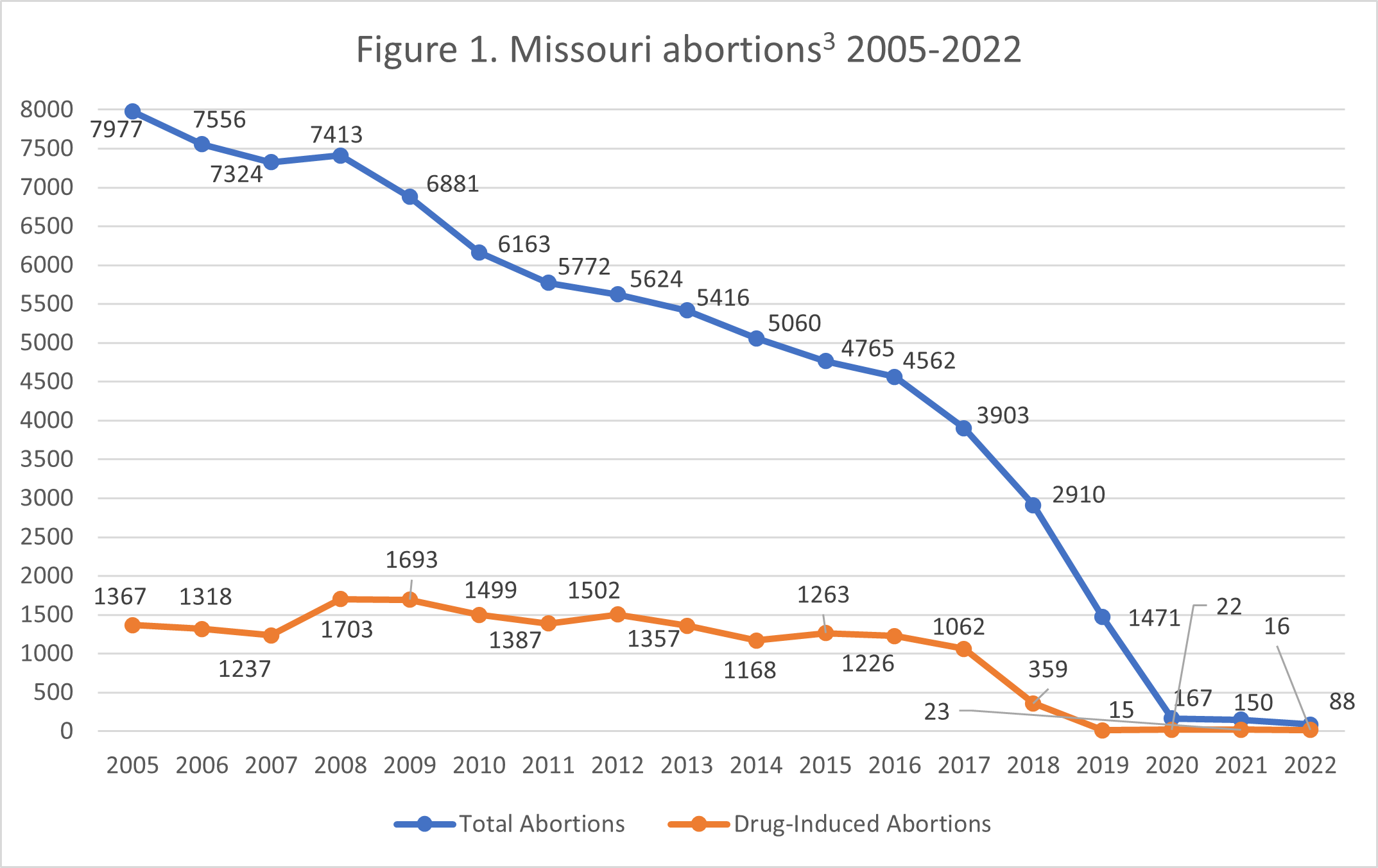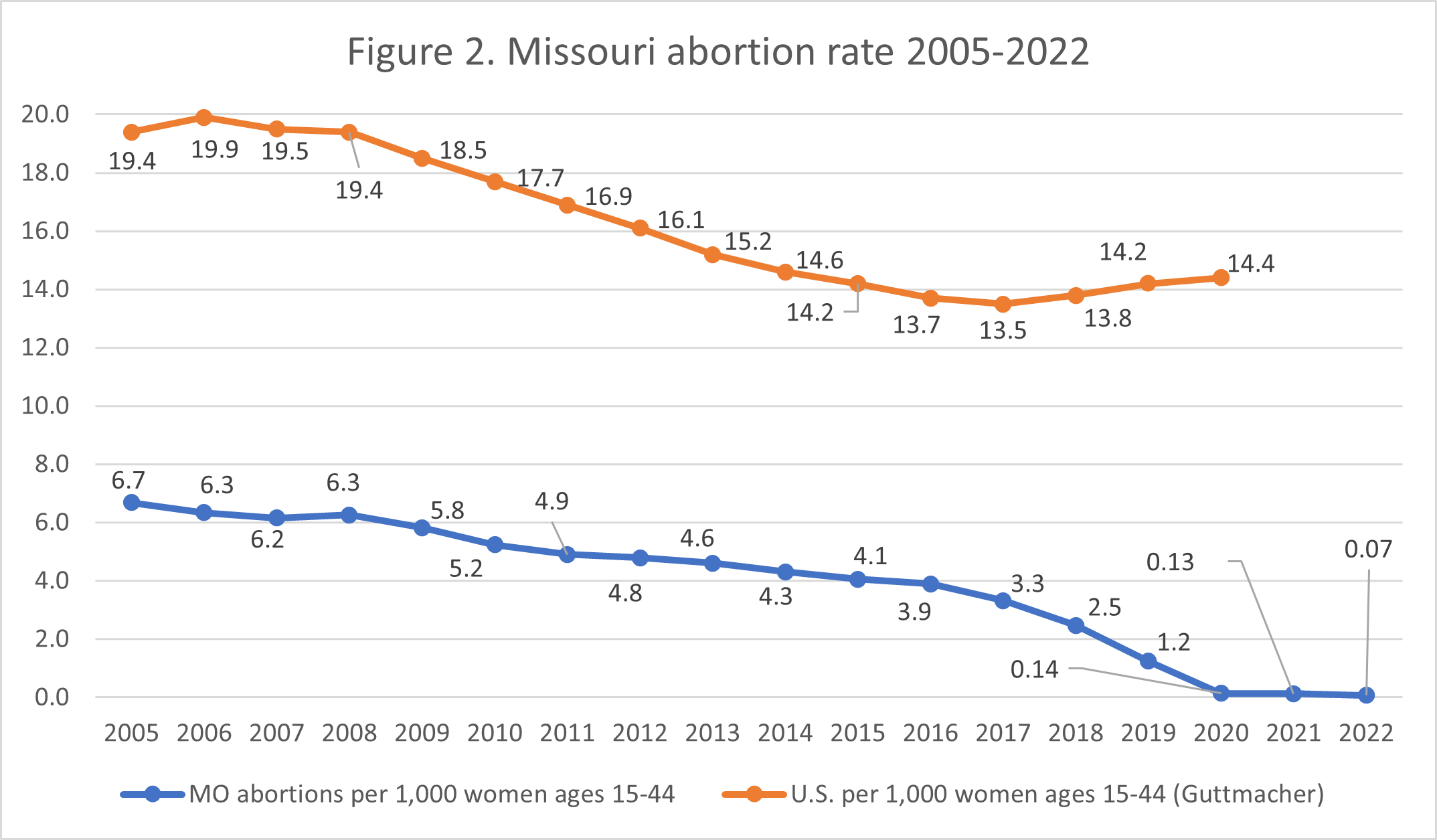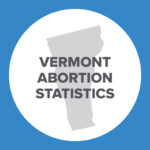Abortion Reporting: Missouri (2022)
Missouri’s 2022 abortion report was published online in May 2024, showing that reported abortions continued to decrease from 2021, reaching the lowest number ever recorded in the state. As of November 2024, 39 states have released 2022 abortion statistics, 16 of which (including Missouri) reported that abortions decreased.
Statistics and Changes in Missouri Abortions, 2021-2022

The report does not include information on Planned Parenthood’s Missouri abortion market share because Planned Parenthood operates no abortion centers in Missouri.
Abortion Totals and Trends
From 150 abortions in 2021 to 88 in 2022, the total number of abortions reported in Missouri fell by 41%. Drug-induced abortions decreased by 30%, from 23 in 2021 to 16 in 2022 (Fig. 1). The Charlotte Lozier Institute (CLI) estimates that Missouri’s 2022 abortion rate was 0.07 abortions per 1,000 women ages 15 to 44 (Fig. 2).1
Separately, Missouri reports abortions performed on residents, both those occurring in Missouri and in other states that share data with Missouri, with residents who obtained abortions out of state primarily doing so in Kansas and Illinois. There were 3,012 abortions performed on Missouri residents in 2022. Resident abortions decreased by 18% from 2021, when there were 3,653 abortions, to 2022.
The data summarized below is broken down into data on Missouri residents, regardless of the location of their abortions, and data on all occurrences of abortion in Missouri, regardless of the residential status of those who obtained abortions.
State Resident Summary
Residence Data
Of the 3,012 abortions known to have been performed on Missouri women in 2022, the majority (58%) were performed on women in their twenties, with 31% on women ages 20 to 24 and 27% on women ages 25 to 29. Thirty-one percent were on women in their thirties, and 4% were on women aged 40 or older. Nine percent of the abortions were on girls under the age of 20, including 2% on girls under the age of 18.
Forty-seven percent of the abortions performed on Missouri residents were on non-Hispanic white women, and 35% were on non-Hispanic black women. Ten percent were on non-Hispanic women of other races, and 7% were performed on Hispanic women. The black abortion rate of 6.8 abortions per 1,000 women ages 15-44 was over four times the white abortion rate of 1.6.
Six percent of the abortions were on women with fewer than 12 years of education. Thirty-five percent of the abortions were performed on women with 12 years of education, another 35% on women with 13 to 15 years, and 16% on women with 16 years of education or more. Level of education was not reported for 8% of abortions. The vast majority of Missouri resident abortions (88%) were on unmarried women. Twelve percent were on married women.
The majority of Missouri women undergoing abortions, 61%, already had children. Twenty-four percent of the abortions were performed on women with one living child and 38% were on women with two or more children, compared to 39% obtained by women with no children. Conversely, the majority of abortions (64%) were performed on women with no previous abortions. Twenty-three percent were on women with one prior abortion, and 13% on women with two or more previous abortions.
Fifty-nine percent of the abortions were performed earlier than nine weeks of gestation (approximately seven weeks post-fertilization), and 74% of these abortions performed before nine weeks gestation were drug-induced. Twenty-one percent of resident abortions occurred between nine and 10 weeks of gestation, and 7% were performed between 11 and 12 weeks, dropping to 5% between 13 and 14 weeks. Three percent were performed between 15 and 16 weeks, and 3% between 17 and 19 weeks. Less than one percent (0.9%) occurred at 20 weeks and 0.8% were reported at 21 weeks of gestation or later. Despite the total number of resident abortions decreasing from 2021 to 2022, the number of abortions performed between nine and 10 weeks increased by 23% and by 14% for abortions performed between 17 and 19 weeks.
There were 1,792 (60%) drug-induced abortions reported to have been performed on Missouri residents, whether in state or in other states that shared data with Missouri. This suggests that the vast majority occurred out of state, as only 16 drug-induced abortions were reported in Missouri in 2022. Thirty percent of the abortions performed on Missouri women were curettage abortions, and 8% were laminaria dilation and evacuation procedures. Fifty-eight abortions were performed using other, unspecified methods.
Occurrence Data
Forty-four percent of the abortions occurring in Missouri were performed on women in their twenties. Forty percent were on women in their thirties, 11% were on women in their forties or older, and 5% were on girls under the age of 20.
Forty-eight percent were performed on non-Hispanic white women. Forty-one percent were on non-Hispanic black women, 8% on non-Hispanic women of other races, and three abortions were performed on Hispanic women.
Unlike the abortions performed on Missouri residents, 15% of the abortions reported in Missouri were performed before nine weeks of gestation. Three percent were performed between nine and 10 weeks, and another 3% between 11 and 12 weeks. While the actual numbers are small, a relatively large percentage of the abortions reported in Missouri occurred in the second trimester. Ten percent of the abortions were reported between 13 and 14 weeks of gestation, while 16% occurred between 15 and 16 weeks and 25% between 17 and 19 weeks of gestation. Ten percent of the abortions were performed at 20 weeks and 17% were performed at 21 weeks or later, for a total of 27% (24 abortions) at or after 20 weeks of gestation.
Compared to 2021, a significantly larger percentage of Missouri abortions were performed between 9 and 12 weeks and between 15 and 19 weeks in 2022. The percentage of abortions performed at or after 21 weeks slightly decreased in 2022 (17%) compared to 2021 (23%). One possible reason for the decrease in abortions performed after 21 weeks is that on the day of the Dobbs decision, Missouri’s life at conception law went into effect. This law protects life at all stages and caused the state’s only remaining abortion center, Reproductive Health Services of Planned Parenthood of the St. Louis Region, to cease abortion services in the state.
Twenty-eight percent of the abortions occurring in Missouri were curettage procedures, while 48% were laminaria dilation and evacuation abortions. There were 16 drug-induced abortions and one hysterectomy or hysterotomy abortion. Four abortions were performed using other, unspecified procedures.
Abortion Complications
Missouri requires medical professionals who treat abortion complications to report them to the Missouri Department of Health and Senior Services (MDHSS), regardless of whether the abortion occurred in Missouri or in a different state. In 2022, MDHSS received 65 complication report forms with information on 115 complications. There was a 20% increase in submitted application forms and a 46% increase in complications compared to the previous year, despite the number of abortions performed in Missouri and the number performed on Missouri residents decreasing significantly from 2021 to 2022.2
Fifty-two percent of the forms were submitted for surgical abortions and 48% for drug-induced abortions. The most common complication was retained products of conception, occurring 28 times, followed by 26 cases of hemorrhage, 19 cases of incomplete abortion, 12 cases each of endometritis and failed abortion in which the pregnancy was undisturbed, and six cases of uterine perforation. There were three cases of cervical laceration, one case of pyrexia, and eight cases of unspecified complications. Thirty-six women were hospitalized, an increase of 44% from 2021 when 25 women were hospitalized.
Only two of the forms submitted were for abortions occurring in Missouri, which MDHSS used to calculate a Missouri complication rate of 2.3 complications per 100 abortions. This means that the vast majority (all but two) of the complication reports involved abortions performed outside of the state, but which doctors in Missouri subsequently had to treat complications for. Missouri does not receive abortion complication reports from other states, so the number of abortion complications suffered by Missouri residents but treated outside of Missouri is unknown.
Out-of-State Abortions
Most abortions performed on Missouri residents occur in other states, many of which then report the abortion data back to Missouri. There were 3,012 abortions performed on Missouri residents in Missouri or reported to Missouri by other states in 2022. However, not all states share individual record-level data with Missouri. In 2022, Illinois and Oklahoma provided estimates of Missouri resident abortions. Missouri reports that when totals from Illinois and Oklahoma are included, there were an estimated 10,255 resident abortions in 2022. While Missouri’s 2022 resident abortion ratio (43.7 abortions on Missouri residents in and outside of Missouri per 1,000 resident women) was the lowest it had been since the state started reporting the data in 1971, the state’s estimated resident ratio of 148.7 (abortions on Missouri residents when estimates given to Missouri by Illinois and Oklahoma per 1,000 resident women) was three times higher than the reported resident ratio by the state.
State Ranking
In 2024, CLI re-evaluated abortion reporting across the country, and Missouri’s reporting ranked 19th best. To improve its reporting, Missouri could add more context to its data by reporting the percentage of abortions performed in Missouri on nonresident women, as well as the states to which Missouri residents travel for abortions. Additionally, Missouri could report pregnancy history, level of education, and marital status for all women undergoing abortions in the state as many other states do.


- National rates were calculated by Guttmacher Institute. Missouri rates were calculated by CLI using the following formula: (total number of abortions performed in Missouri ÷ number of resident women ages 15-44 [based on most recent population estimates]) x 1,000. Rates may differ slightly from previous CLI articles due to revised population estimates. Population estimates were obtained using the CDC WONDER database. Estimates for 2005-2009 are intercensal estimates of the July 1 resident population. Estimates for 2010-2019 are Vintage 2020 postcensal estimates of the July 1 resident population. Estimates for 2020-2022 are Vintage 2022 postcensal estimates of the July 1 resident population. Estimates were produced by the U.S. Census Bureau and the National Center for Health Statistics.
- Statistics on abortion complications reported here represent a minimal number of deaths and complications, and the state acknowledges that this data may be incomplete.
- This figure represents total abortions occurring in Missouri. Abortion totals for 2011 and 2014 were revised in later reports, but because drug-induced abortion totals were not revised, the original numbers provided by the 2011 and 2014 abortion reports have been used to allow for comparison between total and drug-induced abortions.
Click here to view reporting from:2023202120202019201820172016



























